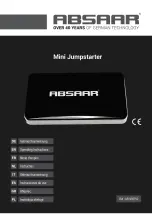
FMA Direct
– 3 –
T-80RF user’s guide
Safety precautions
Radio controlled models are not toys! Please observe these
safety precautions:
Follow all instructions in this manual to assure safe
operation.
If you have not assembled and operated a radio controlled
model before, obtain help from an experienced modeler.
You will need guidance to successfully assemble, test and
operate radio controlled models. One of the best ways to
obtain help is to join your local radio control club.
Never fly radio controlled airplanes near people, buildings,
telephone or power lines, cars, trees or other objects on the
ground or in the air.
Keep
your
radio
controlled models and equipment away
from children. Do not allow unauthorized people of any age
to operate radio controlled models without proper
supervision from an experienced modeler.
In some areas of the country, you cannot legally operate
radio controlled models except at approved fields. Check
with local authorities first.
Observe frequency control. If someone else is operating a
radio controlled model on the same channel as your
transmitter,
do not turn on your transmitter—even for a
short time
. Your transmitter’s channel number is marked
on the crystal cover (see next page). When a model receives
signals from two transmitters on the same channel at the
same time, it cannot be controlled and will crash—possibly
causing personal injury or property damage.
For safety,
most RC flying fields have formal frequency control
rules. Follow them carefully.
Do not operate your radio control transmitter within 3 miles
of a flying field. Even at a distance, your transmitter can
cause interference.
Do not operate radio controlled models and equipment in the
rain, or at night.
Protect all electronic equipment from exposure to rain,
water, high humidity and high temperatures.
Discard batteries in accordance with local waste disposal
and recycling regulations.
FMA Direct recommends that you join the AMA. They can
help you find a club in your area.
Academy
of
Model
Aeronautics
5161 East Memorial Drive
Muncie, Indiana 47302
Phone:
(800)
435-9262
Web:
www.modelaircraft.org
Besides the T-80RF transmitter, you’ll need:
Receiver, operating on the same radio control channel as the
transmitter.
Switch
harness.
Servos for moving aircraft control surfaces.
Optional extension cable for connecting aileron servo to
receiver.
For an engine-powered aircraft: additional servo (for
controlling engine speed), and battery pack to supply power
to receiver and servos.
For an electric motor-powered aircraft: electronic speed
control (for controlling electric motor speed and supplying
power to receiver and servos).
Other radio components you’ll need
Tip:
FMA Direct carries a full line of compatible receiv-
ers, servos, electronic speed controls, battery packs,
chargers and related flight equipment.
1. Locate the end of the antenna having the threaded hole.
2. Gently slide that end of the antenna into the antenna hole in
the top of the transmitter, until the antenna can’t be slid in
any farther (don’t force it).
3. Gently rotate the antenna clockwise (as seen from the top).
Stop rotating when the antenna is secure.
Installing the antenna
Summary of Contents for T-80RF
Page 12: ......






























